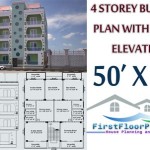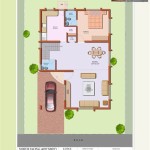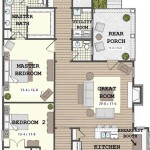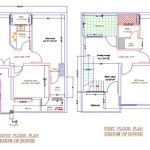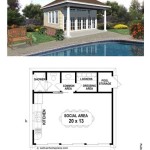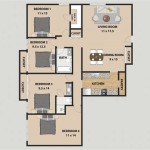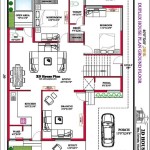House Designs: The Enduring Appeal of Open Plan Living
Open plan living has become a prevalent design choice in modern residential architecture. It describes a spatial arrangement where multiple traditionally separate living areas, such as the kitchen, dining room, and living room, are combined into a single, larger space. This architectural approach offers a variety of benefits, but also presents certain challenges that necessitate careful consideration during the design and implementation phases.
The concept of open plan living emerged as a reaction against the rigid compartmentalization of space that characterized earlier architectural styles. The desire for greater flexibility, increased natural light, and enhanced social interaction fueled its rise in popularity. Instead of distinct rooms designated for specific activities, open plan layouts promote a fluid and integrated living experience. Walls are minimized, creating a sense of spaciousness and connectivity that appeals to many homeowners.
Enhanced Social Interaction
One of the primary drivers behind the adoption of open plan living is its ability to foster social interaction within the home. By eliminating physical barriers between the kitchen, dining area, and living room, family members and guests can remain connected and engaged in conversations and activities regardless of their location within the space. This is particularly advantageous for families with young children, allowing parents to supervise their children while preparing meals or engaging in other tasks. Similarly, when entertaining, the open layout allows hosts to easily interact with guests while preparing food and drinks, creating a more inclusive and convivial atmosphere.
The open flow also encourages spontaneous interaction. Instead of being confined to separate rooms, individuals are more likely to cross paths and engage in casual conversations, strengthening relationships and creating a more vibrant and dynamic home environment. This increased interaction can be especially beneficial in multi-generational households where family members may have different schedules and routines.
Maximization of Natural Light and Space
Open plan designs excel at maximizing the utilization of natural light and available space. The absence of interior walls allows sunlight to penetrate deeper into the home, reducing the need for artificial lighting during the day and creating a brighter, more cheerful atmosphere. This can also have a positive impact on energy efficiency, as reduced reliance on artificial lighting translates to lower electricity consumption.
The removal of walls also creates a visual illusion of greater spaciousness. Even in smaller homes, an open plan layout can make the space feel larger and more airy. This is particularly appealing in urban environments where space is often at a premium. By combining multiple functions into a single area, open plan designs eliminate the need for redundant hallways and corridors, further optimizing the use of available square footage. This efficiency can be particularly attractive to first-time homebuyers or those looking to downsize without sacrificing a sense of spaciousness.
Design Considerations and Potential Drawbacks
While open plan living offers numerous advantages, it's essential to acknowledge its potential drawbacks and carefully consider design choices to mitigate these challenges. One of the main concerns is the lack of privacy. In an open plan layout, noise and activities from one area can easily spill over into another, making it difficult to find a quiet and secluded space for work, relaxation, or focused activities. Strategic use of furniture placement, area rugs, and acoustic panels can help to define zones and absorb sound, creating pockets of relative privacy within the larger space.
Another challenge is maintaining visual appeal and preventing the space from feeling cluttered or disorganized. Without clearly defined boundaries, it's easy for the open plan area to become a dumping ground for belongings. Careful planning of storage solutions, such as built-in cabinets, shelving units, and multi-functional furniture, is crucial for keeping the space tidy and visually appealing. The selection of a cohesive color palette and consistent design style can also help to unify the various elements of the open plan area and create a sense of harmony.
The increased noise levels associated with open plan living can be problematic for individuals who are sensitive to sound or require a quiet environment for focused work. Soundproofing measures, such as installing insulation in the walls and ceilings, using thicker carpets, and incorporating sound-absorbing materials, can help to mitigate noise pollution and create a more peaceful living environment. The use of strategically placed plants can also help to absorb sound and improve air quality.
Temperature regulation can also be a challenge in open plan spaces. Without interior walls to separate different zones, it can be difficult to maintain consistent temperatures throughout the area. This can be particularly problematic in homes with large windows that are exposed to direct sunlight. The use of zoned heating and cooling systems, as well as window coverings such as blinds or curtains, can help to regulate temperature and create a more comfortable living environment.
Finally, cooking odors can easily spread throughout an open plan living area. This can be particularly bothersome for individuals who are sensitive to smells. Installing a powerful range hood that vents to the outside is essential for removing cooking odors and preventing them from lingering in the space. Proper ventilation and air filtration systems can also help to improve air quality and reduce the impact of cooking odors.
Zoning and Defining Spaces
Successfully implementing open plan living requires thoughtful zoning and careful consideration of how different areas will be defined within the larger space. While the goal is to create a sense of openness and flow, it's important to establish clear boundaries between functional zones to prevent the space from feeling chaotic or disorganized. This can be achieved in a variety of ways, including the strategic placement of furniture, the use of area rugs, and the incorporation of architectural elements such as changes in floor height or partial walls.
Furniture placement is one of the most effective ways to define zones in an open plan layout. A large sectional sofa can be used to delineate the living room area from the dining area, while a kitchen island can serve as a natural divider between the kitchen and the rest of the space. The arrangement of furniture should be carefully considered to create a sense of flow and connectivity, while also providing clear boundaries between different functional areas.
Area rugs are another valuable tool for defining zones and adding visual interest to an open plan space. A large area rug can be used to anchor the living room furniture and create a distinct seating area, while smaller rugs can be used to define the dining area or create a cozy reading nook. The use of different colors, patterns, and textures can further enhance the visual separation between zones and add personality to the space.
Architectural elements can also be used to define zones and create a more visually interesting open plan layout. Changes in floor height, such as a raised platform for the dining area or a sunken living room, can create a sense of separation and add visual drama to the space. Partial walls, such as a pony wall or a built-in bookcase, can provide a degree of privacy without completely closing off the space. These architectural elements can help to define zones, create visual interest, and add character to the open plan layout.
Lighting also plays a crucial role in defining zones and creating a welcoming atmosphere in an open plan space. Different types of lighting can be used to highlight different areas and create a sense of depth and dimension. Task lighting, such as pendant lights over the kitchen island or reading lamps in the living room, can provide focused illumination for specific activities. Ambient lighting, such as recessed lighting or wall sconces, can create a soft and inviting glow that fills the entire space. Accent lighting, such as spotlights or track lighting, can be used to highlight artwork or architectural features. By carefully layering different types of lighting, it is possible to create a visually stimulating and functional open plan layout.
In essence, open plan living represents a shift towards a more flexible and interconnected way of living. However, its successful implementation hinges on careful planning, thoughtful design choices, and a clear understanding of both its advantages and potential challenges. By addressing issues related to privacy, noise control, and visual organization, homeowners can create an open plan space that is both functional and aesthetically pleasing.

House Design Trends What S Popular In Cur Floor Plans Extra Space Storage

Modern Open Floor House Plans Blog Eplans Com

30 Gorgeous Open Floor Plan Ideas How To Design Concept Spaces

Seamless Open Plan Living Mojo Homes

Seamless Open Plan Living Mojo Homes

Why Open Plan Living Is For You Fairhaven Homes

Open Plan Living Ideas To Inspire Your Modern Home Checkatrade

Open Plan Living Ideas Maid2match

Pros And Cons Of Open Concept Floor Plans

Seamless Open Plan Living Mojo Homes

